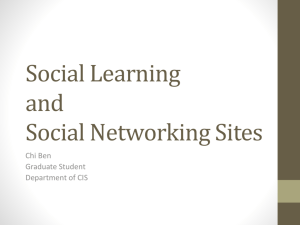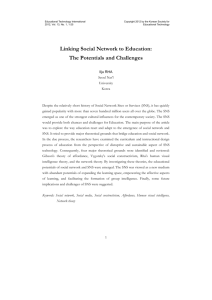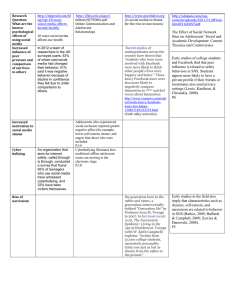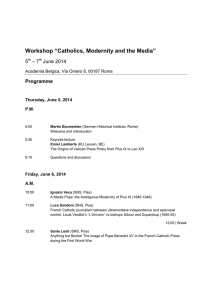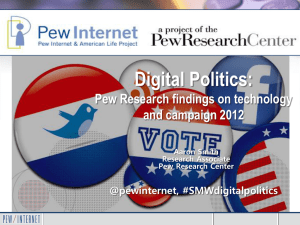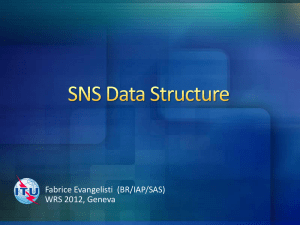Collision of knowledge sharing in social networks SeyedjamalZolhavarieh, and MoloodBarati Abstract.
advertisement
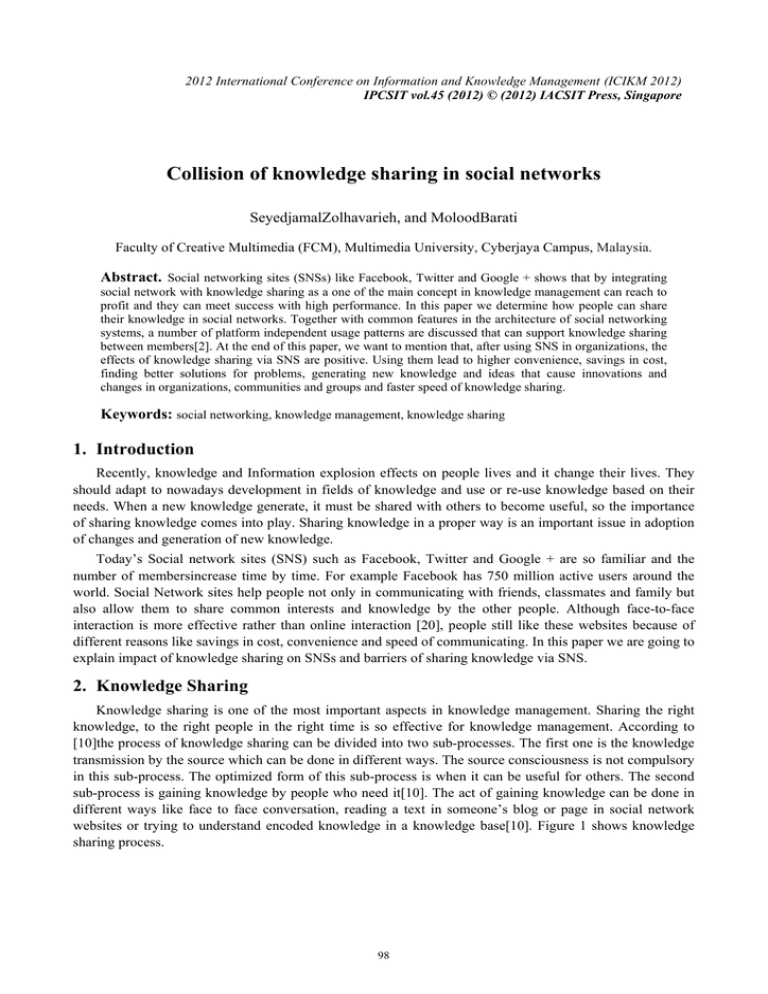
2012 International Conference on Information and Knowledge Management (ICIKM 2012) IPCSIT vol.45 (2012) © (2012) IACSIT Press, Singapore Collision of knowledge sharing in social networks SeyedjamalZolhavarieh, and MoloodBarati Faculty of Creative Multimedia (FCM), Multimedia University, Cyberjaya Campus, Malaysia. Abstract. Social networking sites (SNSs) like Facebook, Twitter and Google + shows that by integrating social network with knowledge sharing as a one of the main concept in knowledge management can reach to profit and they can meet success with high performance. In this paper we determine how people can share their knowledge in social networks. Together with common features in the architecture of social networking systems, a number of platform independent usage patterns are discussed that can support knowledge sharing between members[2]. At the end of this paper, we want to mention that, after using SNS in organizations, the effects of knowledge sharing via SNS are positive. Using them lead to higher convenience, savings in cost, finding better solutions for problems, generating new knowledge and ideas that cause innovations and changes in organizations, communities and groups and faster speed of knowledge sharing. Keywords: social networking, knowledge management, knowledge sharing 1. Introduction Recently, knowledge and Information explosion effects on people lives and it change their lives. They should adapt to nowadays development in fields of knowledge and use or re-use knowledge based on their needs. When a new knowledge generate, it must be shared with others to become useful, so the importance of sharing knowledge comes into play. Sharing knowledge in a proper way is an important issue in adoption of changes and generation of new knowledge. Today’s Social network sites (SNS) such as Facebook, Twitter and Google + are so familiar and the number of membersincrease time by time. For example Facebook has 750 million active users around the world. Social Network sites help people not only in communicating with friends, classmates and family but also allow them to share common interests and knowledge by the other people. Although face-to-face interaction is more effective rather than online interaction [20], people still like these websites because of different reasons like savings in cost, convenience and speed of communicating. In this paper we are going to explain impact of knowledge sharing on SNSs and barriers of sharing knowledge via SNS. 2. Knowledge Sharing Knowledge sharing is one of the most important aspects in knowledge management. Sharing the right knowledge, to the right people in the right time is so effective for knowledge management. According to [10]the process of knowledge sharing can be divided into two sub-processes. The first one is the knowledge transmission by the source which can be done in different ways. The source consciousness is not compulsory in this sub-process. The optimized form of this sub-process is when it can be useful for others. The second sub-process is gaining knowledge by people who need it[10]. The act of gaining knowledge can be done in different ways like face to face conversation, reading a text in someone’s blog or page in social network websites or trying to understand encoded knowledge in a knowledge base[10]. Figure 1 shows knowledge sharing process. 98 Figure 1: Knowledge sharing process(Hendriks, 1999) Two modes of happening knowledge sharing are the passiveand the interactive mode. In the passive mode, the knowledge owner (source) releasesand save his knowledge in social environment. The knowledge userreceives the knowledge but he cannot formulate feedbackto the source. Against of passive knowledge sharing, interactiveknowledge sharing contains a feasible position for the receiver to supply the source withfeedback. By having feedback the persons can see the understanding of the resources and what is the world response. The feasibility tocreate feedback is necessary for some situation which receiver need response of world and understands the source. Finally the source prepareshis knowledge again in a suitable way in order to receiver requirement. In passive knowledge sharing source releases his knowledge and then it can reuse more time by the other receivers and this mode can be high reusable. One of the problems that we face on the passive knowledge sharing is motivation and knowledge in this mode convert to out of date information quickly. The users know that it’s hard to share knowledge by passive mode and when they use knowledge by this mode they cannot decide knowledge is out of date or not and does it has clear view or not, so they should support interactive knowledge sharing be side of passive knowledge sharing. Both modes are useful andshould apply through organizations or between independentindividuals[2]. 3. Social Networking Systems (SNSs) A group of individuals that are virtually connected via internet together who may know each other or not is the definition of SNS. SNSs provide communication, conversation and knowledge sharing for users.In SNS users can post different things like text, audio and video to their friends, join a large variety of groups that are interested in and get to know new people who have same interests with them have categorized the features of SNS which is come in table 1[16]. Table 1: Features of SNS Goal Belonging Duration Cohesion and enabling factors Relation based on individual interests, debate, confront on specific topics, sharing knowledge; multiplicity and heterogeneity of joining interests and motivations Spontaneous and autonomous motivation Non-defined High level of trust (relevance of reputation), sense of responsibility, high technological skills, distributed reflexivity and evaluation (nonautonomous, nor heteronymous but socially spread) Type of relation: share/evaluate Social networking systems have been created to make sure that people can represent their real identity and also allow people to find their same interest. By presenting the common architecture of social networking systems and a number of common usage patterns, this paper discuss about how social 99 networking systems can support knowledge sharing. This is relevant to large organizations, between organizations or among individuals without organizational affiliation. It is necessary to present an overview of some related issues to the sharing of knowledge before expressing how social networking systems can benefit knowledge sharing[2]. 4. Knowledge Sharing in Social Network Sites Social network sites are the base of social interactions. In SNS, users can have the ability to people opinion and also access to their knowledge just in time. According to studies[17], knowing what others know is not usable until accessing to their knowledge in a proper time. SNS give users the ability to communicate, interact and share knowledge with others in a friendly way. SNS can prepare this background to keep engaging users by getting the facilities such as pages and groups. The last factor that should be notified is safety. Safety in every interaction is the key to knowledge sharing[17]. In other words communications between people that have high security can impact directly on learning and sharing knowledge. Choose own friends in social network sites and confirming both parties is necessary for creating safe guaranteed relationship. By adjusting privacy settings of social network site, secure relationships between users will be increased. 5. Barriers of Knowledge sharing via SNS According to Lindsey [11]some main barriers around concept of knowledge sharing in SNSs can consist of: 5.1. Silo mentality It is an important barrier that occurs when departments or groups in an organization do not share knowledge or information with other departments or groups. In other words each department becomes like a silo that is isolated from other departments and does not have any connection with them. Each department may work completely effective individually but they cannot reach the optimal performance [12]. 5.2. Poor Information Technology (IT) systems Nowadays IT plays an important role in all organizations and every community. Because of this reason IT professionals have undeniable duties and they should think about different aspects of IT systems before designing them. When an organization uses old and obsolete IT systems which it cannot be update in every time and also it has future problem for adapting, the organization faces to problematic issue and it cannot have high profit in future. So designing powerful IT systems become vital that can be updated and expanded easily with just minor changes[14]. 5.3. Poor SNS and Portals Design of SNS should be user friendly and easy to understand. When a user uses a simple SNS, he/she can easily interact with other people and share knowledge with them by means of getting use of different media like video and audio. On the other hand when the design of SNS and portals are nested and not user friendly the user’s preference to register in them decreases[13]. 5.4. Poor web content management SNS should be designed flexible and easy to use, manage and expand by users. In other words expanding and managing of SNS should not be done just by web experts. In addition poor web content management may limit users. In this case, all people in an organization cannot access to SNS and get use of its features[19]. A power content management system (CMS) provides a collection of procedures used to manage work flow in a collaborative environment. The procedures are designed to do the following: • • Allow for a large number of people to contribute to and share stored data Control access to data, based on user roles (defining which information users or user groups can view, edit, publish, etc.) 100 • • • • • Aid in easy storage and retrieval of data Control of data validity and compliance Reduce repetitive duplicate input Improve the ease of report writing Improve communication between users 6. Conclusion To sum up this paper, we want to mention that, after implementing portal or using SNS in organizations, the effects of knowledge sharing via portals or SNS are positive. Using them lead to higher convenience, savings in cost, finding better solutions for problems, generating new knowledge and ideas that cause innovations and changes in organizations, communities and groups and faster speed of knowledge sharing. In addition communities and organizations should be aware of barriers, may appear for knowledge sharing via SNS to reach the optimal performance. Finally motivating users or employees to use portals and SNS to share the right knowledge to the right people at the right moment via SNS or portals is another important issue that should not be overlooked. 7. References [1] Burt, R. S. (1997). The contingent value of social capital. Administrative science quarterly, 339-365. [2] Coenen, T., Kenis, D., Van Damme, C., & Matthys, E. (2006). Knowledge sharing over social networking systems: Architecture, usage patterns and their application. [3] Deci, E. L., Koestner, R., & Ryan, R. M. (1999). A meta-analytic review of experiments examining the effects of extrinsic rewards on intrinsic motivation. Psychological bulletin, 125(6), 627. [4] Deci, E. L., & Ryan, R. M. (1985). Intrinsic motivation and self-determination in human behavior: Springer. [5] Ellison, N. B. (2007). Social network sites: Definition, history, and scholarship. Journal of Computer‐Mediated Communication, 13(1), 210-230. [6] Foss, N. J., Minbaeva, D. B., Pedersen, T., & Reinholt, M. (2009). Encouraging knowledge sharing among employees: How job design matters. Human Resource Management, 48(6), 871-893. [7] Frey, B. S. (1997). Not just for the money: E. Elgar. [8] Hanson, B. S., Isacsson, S. O., Janzon, L., & Lindell, S. E. (1989). Social network and social support influence mortality in elderly men. American Journal of Epidemiology, 130(1), 100-111. [9] Heaney, C. A., & Israel, B. A. (2002). Social networks and social support. Health behavior and health education: Theory, research, and practice, 3, 185-209. [10] Hendriks, P. (1999). Why share knowledge? The influence of ICT on the motivation for knowledge sharing. Knowledge and process management, 6(2), 91-100. [11] Lindsey, K. L. Barriers to Knowledge Sharing. [12] Merrill, J., Caldwell, M., Rockoff, M. L., Gebbie, K., Carley, K. M., & Bakken, S. (2008). Findings from an organizational network analysis to support local public health management. Journal of Urban Health, 85(4), 572584. [13] Neumann, M., O'Murchu, I., Breslin, J., Decker, S., Hogan, D., & MacDonaill, C. (2005). Semantic social network portal for collaborative online communities. Journal of European Industrial Training, 29(6), 472-487. [14] Orlikowski, W. J., & Robey, D. (1991). Information technology and the structuring of organizations. Information systems research, 2(2), 143-169. [15] Osterloh, M., & Frey, B. S. (2000). Motivation, knowledge transfer, and organizational forms. Organization science, 538-550. [16] Pettenati, M., & Cigognini, M. (2007). Social networking theories and tools to support connectivist learning activities. International Journal of Web-Based Learning and Teaching Technologies (IJWLTT), 2(3), 42-60. [17] PRUSAK, R. O. B. C. A. P. L., & Borgatti, S. P. (2001). Supporting knowledge creation and sharing in social 101 networks. Organizational dynamics, 30(2), 100-120. [18] Skeels, M. M., & Grudin, J. (2009). When social networks cross boundaries: a case study of workplace use of facebook and linkedin. [19] Vidgen, R., Goodwin, S., & Barnes, S. (2001). Web content management. [20] Vitak, J. (2008). Facebook" Friends": How Online Identities Impact Offline Relationships. 102
